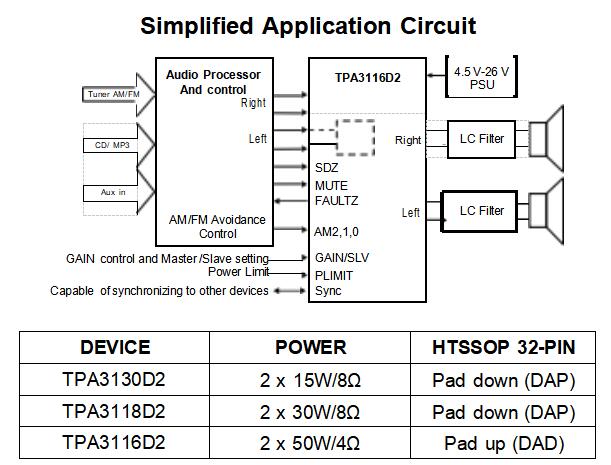
15W,30W,50W Filter-Free Class-D Stereo Amplifier Family with AM Avoidance
Check for Samples: TPA3116D2 , TPA3118D2, TPA3130D2
FEATURES
• Supports Multiple Output Configurations
– 2×50-W into a 4-Ω BTL Load at 21 V (TPA3116D2)
– 2×30-W into a 8-Ω BTL Load at 24 V (TPA3118D2)
– 2×15-W into a 8-Ω BTL Load at 15 V (TPA3130D2)
• Wide Voltage Range: 4.5 V – 26 V
• Efficient Class-D Operation
– >90% Power Efficiency Combined with Low Idle Loss Greatly Reduces Heat Sink Size
– Advanced Modulation Schemes
• Multiple Switching Frequencies
– AM Avoidance
– Master/Slave Synchronization
– Up to 1.2 MHz Switching Frequency
• Feedback Power Stage Architecture with High PSRR Reduces PSU Requirements
• Programmable Power Limit
• Differential/Single-Ended Inputs
• Stereo and Mono Mode with Single Filter Mono Configuration
• Single Power Supply Reduces Component Count
• Integrated Self-Protection Circuits Including Over-Voltage, Under-Voltage, Over- Temperature, DC-Detect, and Short Circuit with Error Reporting
• Thermally Enhanced Packages
– DAD (32-pin HTSSOP Pad-up)
– DAP (32-pin HTSSOP Pad-down)
• –40°C to 85°C Ambient Temperature Range
APPLICATIONS
• Mini-Micro Component, Speaker Bar, Docks
• After-Market Automotive
• CRT TV
• Consumer Audio Applications
DESCRIPTION
The TPA31xxD2 series are stereo efficient, digital amplifier power stage for driving speakers up to 100W/2Ωin mono. The high efficiency of the TPA3130D2 allows it to do 2x15W without external heat sink on a single layer PCB. The TPA3118D2 can even run 2x30W/8Ω without heat sink on a dual layer PCB. If even higher power is needed the TPA3116D2 does 2x50W/4Ω with a small heat-sink attached to its top side PowerPad. All three devices share the same footprint enabling a single PCB to be used across different power levels.
The TPA31xxD2 advanced oscillator/PLL circuit employs a multiple switching frequency option to avoid AM interferences; this is achieved together with an option of Master/Slave option, making it possible to synchronize multiple devices.
The TPA31xxD2 devices are fully protected against faults with short-circuit protection and thermal protection as well as over-voltage, under-voltage and DC protection. Faults are reported back to the processor to prevent devices from being damaged during overload conditions.
